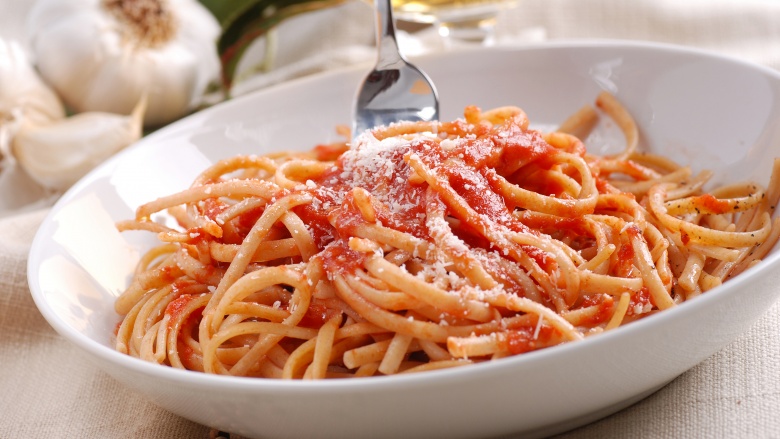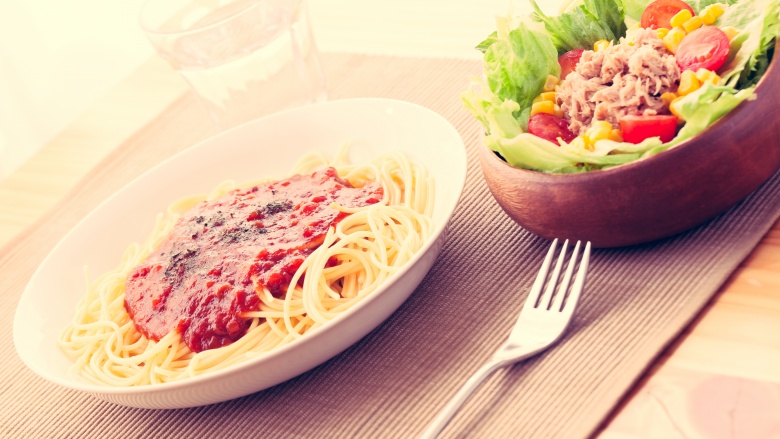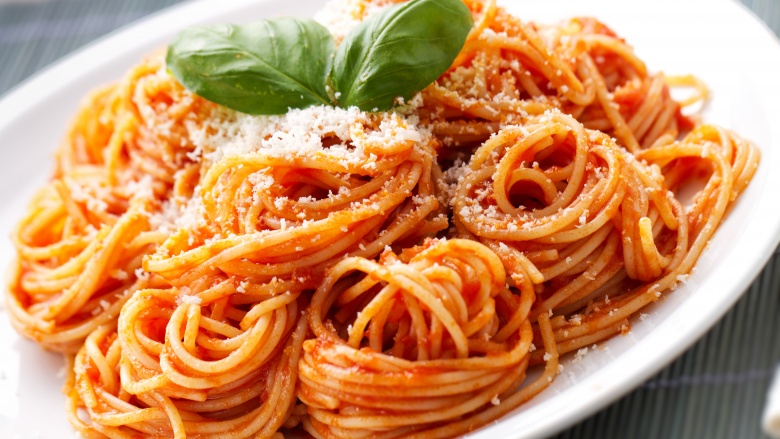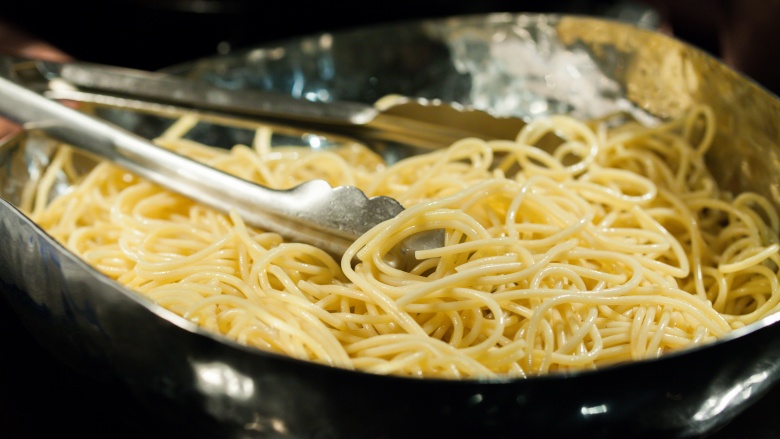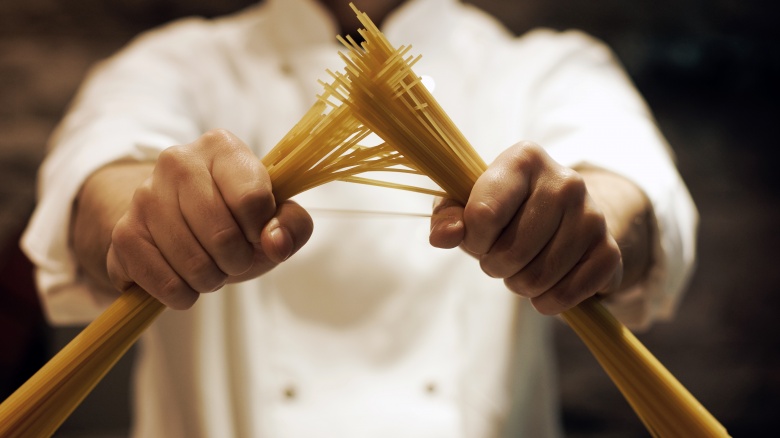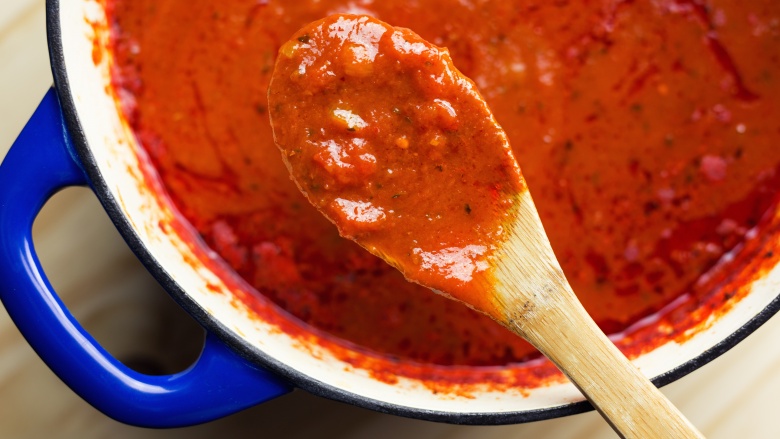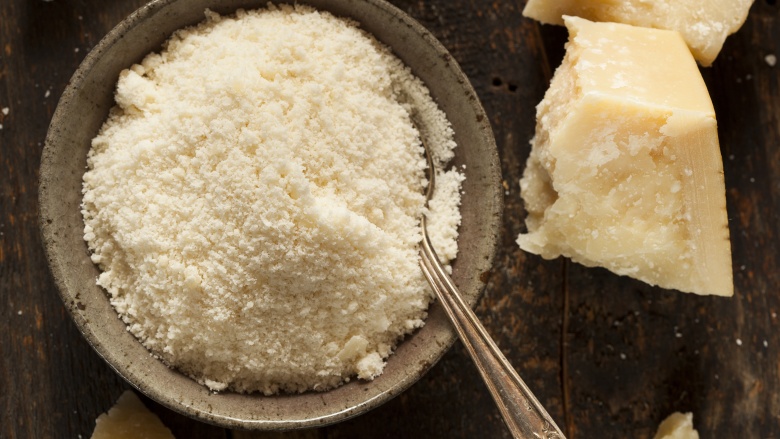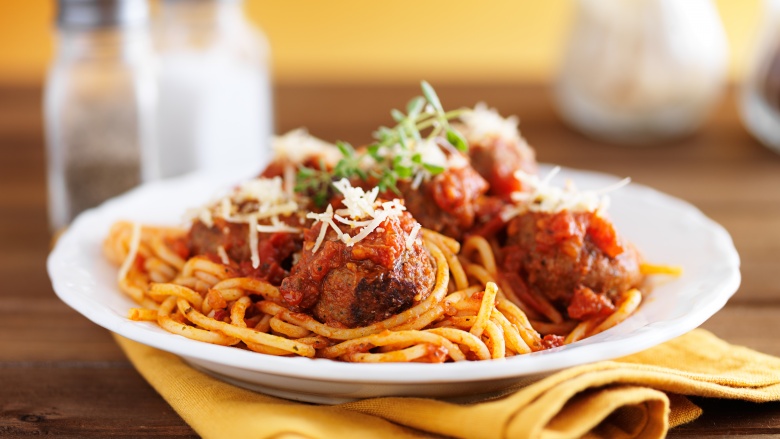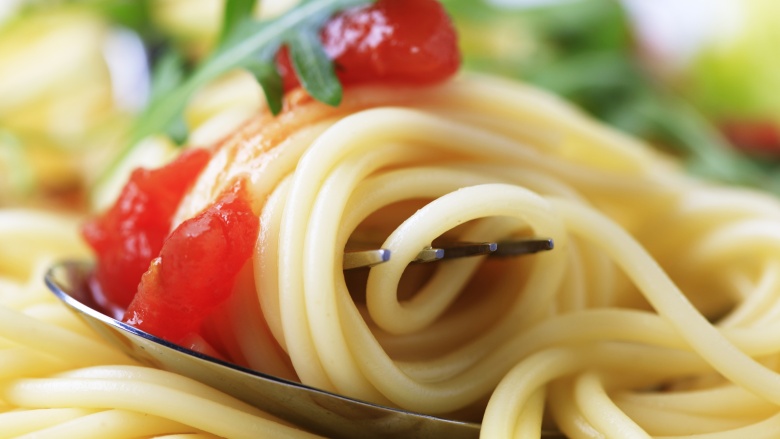How To Eat Spaghetti Like A True Italian
When you think of your favorite Italian food, what comes to mind? For many, it's probably a giant plate of spaghetti noodles, topped with a hearty meat sauce and a generous serving of juicy meatballs — maybe even with a hefty sprinkling of grated Parmesan cheese on top. Unfortunately, that dish you're envisioning isn't the least bit Italian. It may be a signature dish of many Italian-style restaurants in the United States — but that doesn't make it (or those restaurants, for that matter) very authentic. In fact, that dish doesn't bear much resemblance at all to the Italian dishes that started our love for spaghetti, or the way true Italians eat the dish today.
I spoke with a few chefs and real-life Italians to get more of a feel for how it's supposed to be done. What I learned was just how much we're screwing it all up. Here's how to eat spaghetti like a true Italian.
The wrong course
In the U.S., we tend to start off with salad, followed by the main course — which is where the spaghetti comes into play. This is the first indicator that we have no idea what we're doing when it comes to real Italian food.
Carla Gomes, Italian by heritage and co-owner of three award-winning restaurants in Boston's North End, travels to Italy several times a year to study their food trends. She says their entire course system is different from how we eat in the United States, as is where they place the pasta dish. "They will start with antipasti (appetizers), then go to primi (pasta), then secondi (meat) dishes. Their lunch is their biggest meal of the day, then everyone goes home for siesta for a few hours."
"Pasta dishes aren't meant to be too filing," added Chef Sal Scognamillo of Patsy's Italian Restaurant in New York City. That's pretty much the exact opposite of the American train of thought, isn't it?
The portion size
In America, the spaghetti is the main attraction, so it's generally served in large portions, but we're the only ones who do it that way. "In Italy, their portion sizes are always much smaller for pasta because pasta is never the entire meal," explained Carla Gomes.
A chef, nutritionist, and daughter of two Italians, Amanda Santucci says the proper spaghetti serving in Italy is around 4 or 5 ounces, "a little more than a half of bowl of pasta in America," she added.
Cooking the noodles
If you're going to eat spaghetti like a true Italian, it's best to do it as they do from the beginning. You may be under the assumption that true Italians always make their own fresh pasta from scratch, but that's not actually how it's done. In fact, even in Italy, boxed pasta has sometimes been more popular than the from-scratch stuff, both because of the simplicity for the chef, and the favorable quality of the boxed varieties.
"First and foremost, pasta should always be prepared al dente, so it's not overcooked," said chef Luigi Diotauti, award-winning chef, restaurateur, sommelier, and cookbook author from Basilicata, Italy. Cooking pasta al dente means cooking the noodles until they are tender but still chewy and not overly soft or mushy. What you do after it's cooked to perfection matters, too. "Never rinse spaghetti after cooking. In doing this, the sauce will stick to the pasta, resulting in flavor in every bite," said chef Phil Yandolino from Brio Tuscan Grille and Bravo Cucina Italiana.
Don't break the noodles
Anyone who has ever cooked a spaghetti dinner knows that initially, those long noodles don't fit too well into most pots. But if you want to eat your spaghetti the right way, it's best to just deal with it. The noodles should never be broken before cooking or cut with a knife once they're on your plate, according to Frank Scafidi, whose parents owned an Italian deli and grocery store. "You might as well put it into a blender and then pour it into a bowl. That makes spaghetti nothing more than 'spoonable' pasta — and there's an Italian phrase for that — acini de pepe. We sold lots of that in our store, too, for people who intended to make a pasta-based soup," he said." Frankly, spaghetti is best enjoyed when it can retain its length as it makes its approach to your taste buds. Doing anything too exotic to it before it reaches your mouth is to deny yourself of one of life's great dining traditions."
The sauce matters
That rich and meaty sauce you're used to is nothing real Italians would ever use to top their plates of spaghetti.
"The most classic spaghetti in Italy is aglio olio, made only with garlic and olive oil. Although it doesn't have a real sauce, its deliciousness lies in its simplicity. Italians love to eat aglio olio all the time, even as a late-night food after parties — it's filling, tasty, and gives you energy," said chef Luigi Diotauti. "Spaghetti alle vongole (with clams) or pasta with a fresh tomato sauce are also traditional dishes. Italians are very light-handed with sauce, which is different than how Americans serve pasta. Adding too much sauce can make the dish unhealthy, and it won't look or taste as good."
Executive chef Nic Yanes of Juniper, who specializes in serving Italian dishes made with old world techniques, says the Italian tradition of sauce to pasta is simple, "The thinner the noodle, the thinner the sauce."
Too much cheese
How long does it take you to say "when" when the waitress is piling mounds of cheese onto your spaghetti dish at your favorite Italian restaurant? If you were a true Italian, you would stop her almost immediately.
"Real Italians also only use a little bit of Parmesan, not too much cheese," said chef Sal Scognamillo of Patsy's Italian Restaurant in New York. It seems the good people of Italy have a lot more restraint that we do when it comes to cheesy toppings — or maybe they just know that the cheese takes away from the real flavor of the dish, which is kind of the whole point.
Executive chef Mark Sparacino of the Italian-American supper club Sophia's in Austin, Texas, echoed that thought, adding that some spaghetti dishes don't get cheese at all. "Italians never put Parmesan cheese on seafood pasta. This is something you see often in America," he said.
Skip the meatballs
If you're a die-hard fan of spaghetti and meatballs, you're about to be sorely disappointed. Italians simply don't eat that dish. Meatballs may be served (maybe even with a marinara sauce), but only as their own course, and under the name polpettes. Chef Mike Dalton, executive chef for the D'Amico & Partners Italian restaurants, explained this, saying, "Pasta is served as its own course, prior to the protein. It isn't paired with meat or fish."
Ditch the spoons
Growing up, I remember my mom teaching me twirl my spaghetti on a fork, using a spoon to keep it all in place. Though I left the spoon behind a long time ago, my mom still eats it that way, which would, apparently, be looked down upon in Italy.
Nutritionist Joni Rampolla says her new in-laws gave her quite the lesson on Italian culture when she married into their very Italian family, and one of the first lessons involved getting rid of that twirling spoon. "Italians never use a spoon to eat spaghetti as many Americans do. Only children are permitted to twirl against the spoon. Adults ground the fork on the bottom of the plate (no bowls, please) and twirl to capture a fork-full that fits nicely in your mouth," she explained.
Chef Mike Dalton, executive chef for the D'Amico & Partners Italian restaurants, agrees that spoons are a no-go with spaghetti, saying, "A spoon is only served with pasta if it is in a broth."
Now that you know how the real Italians do it, step outside of your comfort zone and try eating your spaghetti the traditional way — you might even find that you enjoy their way of doing things. After all, they're the experts, right?
